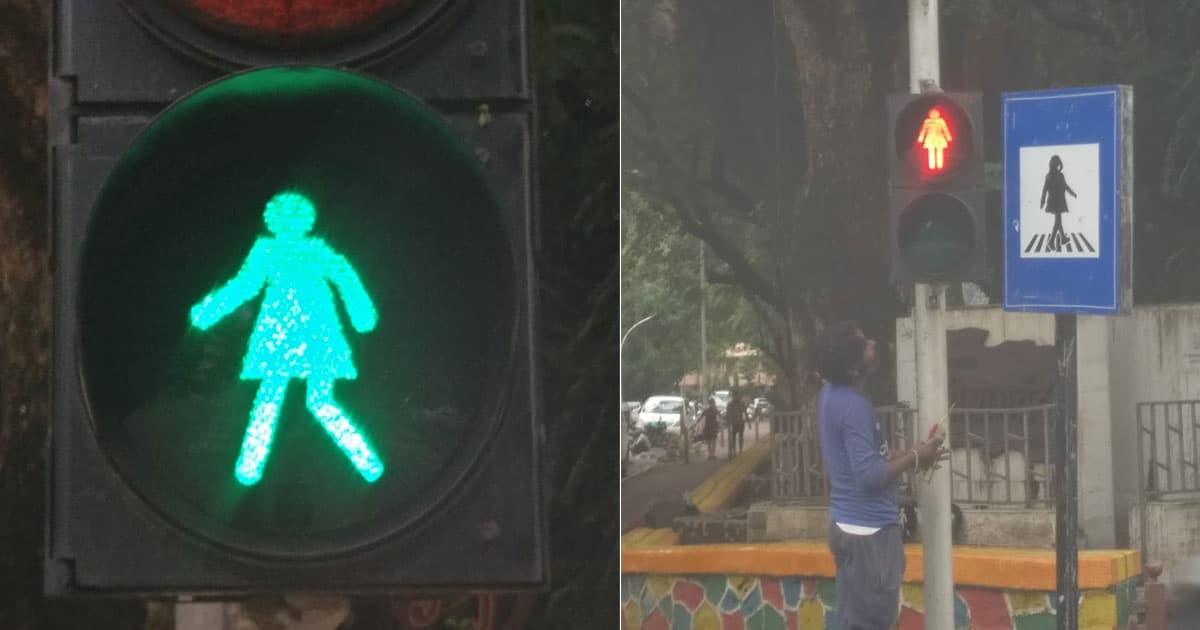In a symbolic gesture, Mumbai green-lights gender inclusivity, as the city’s civic body, Brihanmumbai Municipal Corporation (BMC), has introduced representative women icons on some of its traffic signals for promoting gender equality.
As part of its ‘Cultural Spine’ project, the civic body has replaced the male stick figures on red and green traffic signals and signboards of 120 pedestrian crossings in the Dadar area, the ‘G North’ ward of Mumbai, with icons wearing triangular dresses to represent women.

The Announcement
“If you’ve passed by Dadar, you’d see something that will make you feel proud. BMC’s ‘G North’ ward is ensuring gender equality with a simple idea- the signals now have women too!,” Maharashtra Tourism Minister Aaditya Thackeray took to Twitter expressing his joy.
If you’ve passed by Dadar, you’d see something that will make you feel proud. @mybmcWardGN is ensuring gender equality with a simple idea- the signals now have women too! pic.twitter.com/8X0vJR8hvQ
— Aaditya Thackeray (@AUThackeray) August 1, 2020
“Delighted to see the efforts of the BMC for ‘the correct signal’ being recognized by UN Women. Some may say this is only ‘signaling’, but equality cannot be measured, it has to begin in the way we think. Each such step, matters!” Mr. Thackeray further added.
“Here’s #SomeGoodNews! Vertical traffic light Mumbai is changing some of its traffic lights to be gender inclusive,” the global body United Nations Women has also hailed the move as a positive change towards greater inclusivity.
Here’s #SomeGoodNews! 🚦 Mumbai is changing some of its traffic lights to be gender inclusive. 🚦 via @CNNStylehttps://t.co/6vCHS6i2ut
— UN Women (@UN_Women) August 6, 2020
“It’s good that we are taking such initiatives. Now people have started recognizing women’s power and they are given equal importance in society. It’s a good initiative to achieve women empowerment,” Nimisha Warrier, a resident of the city told the media.
The Netizens React
While the effort has received accolades and praises for attempting to change the public perception and increase the visibility of women in the public spheres, the issue also remained at the helm of the debate and rendered netizens in splits.
“This is one small yet decisive step forward to ending the subconscious exclusion of the female narrative from how our cities are designed,” an architect and urban planner by profession, Dipika Lele took to Twitter hailing the move. “The women gender has gained some more presence and acceptance as the new normal,” said another woman architect on Twitter.
“Real empowerment comes when the law protects the dignity of women not merely putting them on traffic lights,” at the same time, another Twitter user replied to Mr. Thackeray’s announcement by pointing at the inefficacy of the move as a ‘waste of time’. Besides, there were ripples of trolls mocking the signals in a regressive manner.
I think its a sheer waste of time. Real empowerment comes when the law protects the dignity of women not merely putting them on traffic lights. Another pappu in making
— @BeingManoj (@manojsoumya) August 1, 2020
“U mean to say, These red and green light signals are only for females and not the males. what is the logic? Are you trying to control only females and giving free hand to males? What about other animals, no signals for them, are they not Indian nationals?,” one of the most regressive comments to Mr. Thackeray’s tweet mentioned.
At The World Stage
Although new to India, this is not unheard of at the world stage. Prior to Mumbai’s latest initiative, symbolic gender-inclusive representation in the urbanscape has been attempted multiple times across the world. Street crossings featuring both male and female stick figures have been prominent in a number of German cities.
Austrian capital Vienna installed icons indicating same-sex couples to its traffic signals in 2015. Geneva, the Swiss city, has also announced such inclusive representation alongside including more diverse figures like pregnant women, women of African origin, and women holding hands.
At the same time, the attempt had met with several criticisms for representing a heteronormative assumption of conventional gendered figures with men in pants and women in skirts Australian city Melbourne.
Delving into the theoretical details regarding the move may highlight some of the problems of the move in terms of reinstating different types of heteronormative dress-stereotypes and obliterating other sexual minorities from gaining adequate visibility.
At the same time, in the Indian context where women face daily harassment in the public spheres of the urban spaces, the symbolic gesture remains a strong reminder of women reclaiming public spaces despite oppression, control, and insecurities.
In reality, symbolism comes with limited capacity in bringing actual change, though it is unparalleled in striking a discourse towards positive change. Despite the stark Indian reality of gender inequality, the very fact that the move sparks a conversation towards identifying gender blindness and obliviousness in everyday lives should be hailed as a positive step towards creating a ‘new normal’ on the streets.

